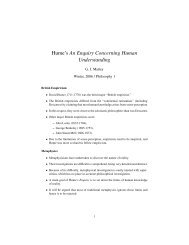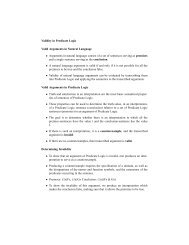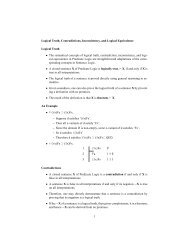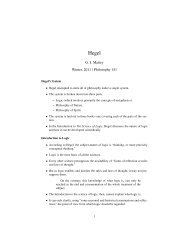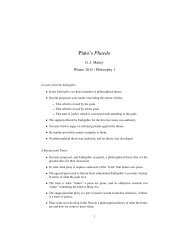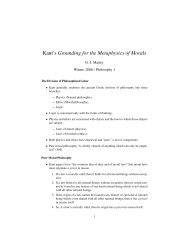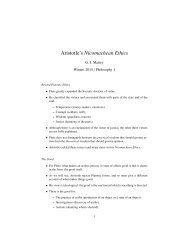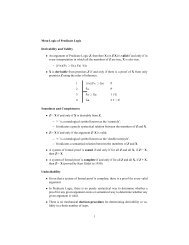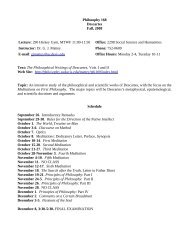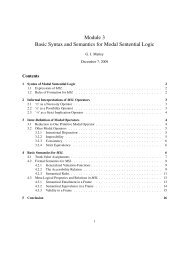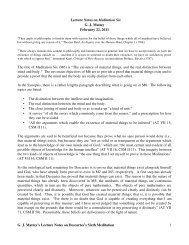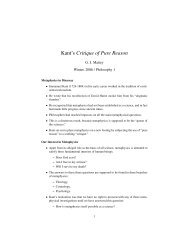Object Language and Metalanguage Formal Languages • Sentence ...
Object Language and Metalanguage Formal Languages • Sentence ...
Object Language and Metalanguage Formal Languages • Sentence ...
Create successful ePaper yourself
Turn your PDF publications into a flip-book with our unique Google optimized e-Paper software.
<strong>Object</strong> <strong>Language</strong> <strong>and</strong> <strong>Metalanguage</strong><br />
<strong>Formal</strong> <strong>Language</strong>s<br />
<strong>•</strong> <strong>Sentence</strong> Logic <strong>and</strong> Predicate Logic are formal languages.<br />
<strong>•</strong> A formal language is a set of sentences generated by rules of formation from a<br />
vocabulary.<br />
<strong>•</strong> The sentences of <strong>Sentence</strong> Logic <strong>and</strong> Predicate Logic are not part of natural<br />
language (though some may resemble natural-language sentences).<br />
<strong>•</strong> The formal languages <strong>Sentence</strong> Logic <strong>and</strong> Predicate Logic are the objects of our<br />
study, <strong>and</strong> as such they are called object languages.<br />
The <strong>Metalanguage</strong><br />
<strong>•</strong> If we are going to state anything about an object language, we must make use of<br />
a language.<br />
<strong>•</strong> We call a language used to study an object language a metalanguage.<br />
<strong>•</strong> In theory, the metalanguage may be identical to or include the object language.<br />
– We use English to study English in linguistics.<br />
<strong>•</strong> We will strictly separate our metalanguage (English with some extra technical<br />
vocabulary) from our object languages.<br />
<strong>•</strong> Keeping the languages separate allows us to avoid semantical paradox (Tarski).<br />
Use <strong>and</strong> Mention<br />
<strong>•</strong> When we talk about an item of language, we are said to mention it.<br />
<strong>•</strong> Whenever an item of any object language is mentioned, it must be placed within<br />
single quotation marks.<br />
<strong>•</strong> We may use English to mention an item of English.<br />
– ‘Bush’ has four letters <strong>and</strong> starts with a ‘B’.<br />
– ‘George W. Bush was born in Texas’ is false.<br />
– ‘This sentence is false’ is true.
Metavariables<br />
<strong>•</strong> We may also use English to mention items of <strong>Sentence</strong> Logic <strong>and</strong> Predicate<br />
Logic.<br />
– ‘⊃’ is a connective of <strong>Sentence</strong> Logic.<br />
– ‘P ⊃ Q’ is a conditional.<br />
– If ‘P’ is true <strong>and</strong> ‘P ⊃ Q’ is true, then ‘Q’ is true.<br />
<strong>•</strong> To state general facts about <strong>Sentence</strong> Logic <strong>and</strong> Predicate Logic, we must use<br />
expressions that designate classes of items of the object language.<br />
<strong>•</strong> Such expressions are called metavariables.<br />
Metavariables for <strong>Sentence</strong>s <strong>and</strong> Sets of <strong>Sentence</strong>s<br />
<strong>•</strong> To mention metavariables themselves, single quotation marks must be used.<br />
<strong>•</strong> ‘Q’ through ‘Z’ will be used as metavariables for sentences of both <strong>Sentence</strong><br />
Logic <strong>and</strong> Predicate Logic.<br />
<strong>•</strong> ‘X’ through ‘Z’ will be used as metavariables for sets of sentences of both <strong>Sentence</strong><br />
Logic <strong>and</strong> Predicate Logic.<br />
Metavariables <strong>and</strong> Connectives<br />
<strong>•</strong> In English, we refer to connectives of <strong>Sentence</strong> Logic using such expressions as<br />
‘sign of negation’ or ‘sign of the conditional’.<br />
<strong>•</strong> We may also refer to them by mentioning them:<br />
– ‘∼’<br />
– ‘⊃’<br />
<strong>•</strong> We must have a way to combine our use of metavariables with reference to connectives.<br />
Names of Themselves<br />
<strong>•</strong> We could make general statements about connectives using English.<br />
– If X is a sentence of <strong>Sentence</strong> Logic, then the result of prefixing the sentence<br />
X refers to with a ‘∼’ (or sign of negation) <strong>and</strong> surrounding the result<br />
with parentheses is a sentence of <strong>Sentence</strong> Logic.<br />
<strong>•</strong> This kind of statement is obviously very cumbersome.<br />
<strong>•</strong> We want to say: ‘If X is a sentence, then (∼X) is a sentence’.<br />
<strong>•</strong> Strictly speaking, this mixes the object language with the metalanguage.<br />
<strong>•</strong> So we say (without paradox) that in ‘∼X’, ‘∼’ is used as a name of itself, or<br />
autonymously (Carnap).<br />
2
Metavariables for Predicate Logic<br />
Sets<br />
<strong>•</strong> The vocabulary of Predicate Logic is an extension of the vocabulary of <strong>Sentence</strong><br />
Logic.<br />
<strong>•</strong> It contains all the expressions of the vocabulary of <strong>Sentence</strong> Logic along with<br />
other expressions proper to Predicate Logic.<br />
<strong>•</strong> The metavariables for these new vocabulary items will be introduced when the<br />
vocabulary items themselves are introduced.<br />
<strong>•</strong> An important part of the metalanguage for <strong>Sentence</strong> Logic <strong>and</strong> Predicate Logic<br />
is set-theoretic notation.<br />
– We have already described metavariables referring to sets of sentences.<br />
<strong>•</strong> Sets are indicated by enclosure in curly brackets ‘{’ <strong>and</strong> ‘{’.<br />
<strong>•</strong> ‘{P, P ⊃ Q}’ indicates the set consisting of ‘P’ <strong>and</strong> ‘P ⊃ Q’.<br />
<strong>•</strong> Ordered sets are indicated by enclosure in angle brackets ‘〈’ <strong>and</strong> ‘〉’. ‘〈P, P ⊃<br />
Q〉’ indicates the set consisting of ‘P’ <strong>and</strong> ‘P ⊃ Q’ in that order: first ‘P’ <strong>and</strong> then<br />
‘P ⊃ Q’.<br />
Specifying Sets<br />
<strong>•</strong> There are two methods of specifying the contents of a set.<br />
<strong>•</strong> The method of enumeration simply lists the contents of the set using linguistic<br />
items that refer to the objects in the set.<br />
– {The President of the United States, Donald Rumsfeld, 2005}<br />
– 〈Adam, Eve〉<br />
The method of description states what condition must be satisified for something<br />
to be a member of the set.<br />
– {x: x is blond}: the set of all x such that x is blond, or the set of all blonds<br />
– {〈x,y〉: x > y}: the set of all ordered pairs x <strong>and</strong> y such that x is greater<br />
than y<br />
3




